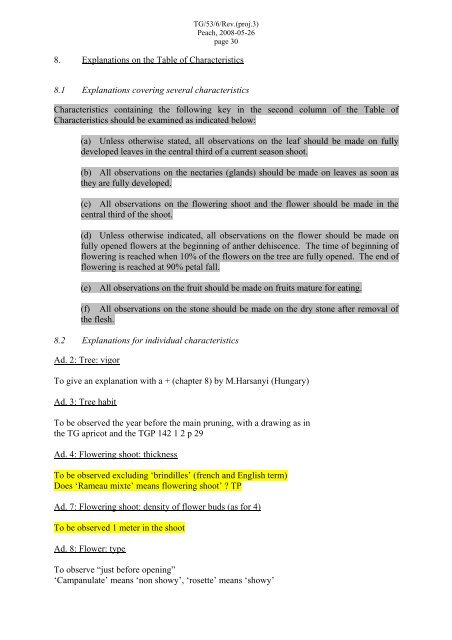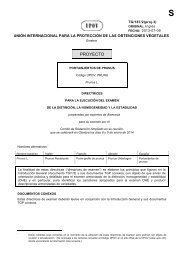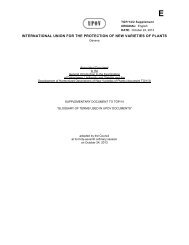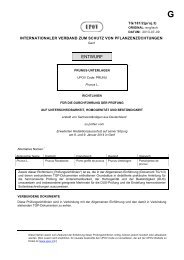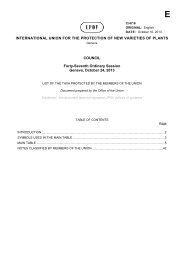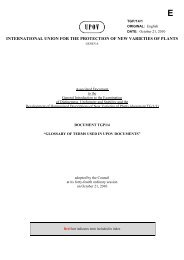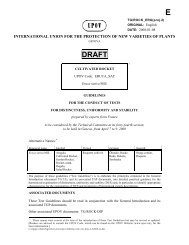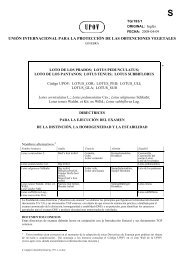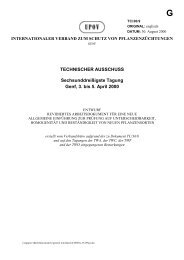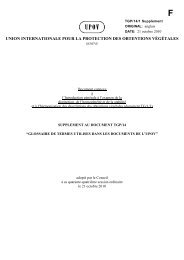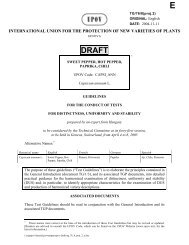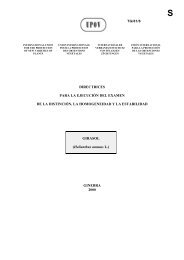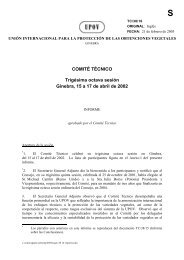draft - International Union for the Protection of New Varieties of Plants
draft - International Union for the Protection of New Varieties of Plants
draft - International Union for the Protection of New Varieties of Plants
Create successful ePaper yourself
Turn your PDF publications into a flip-book with our unique Google optimized e-Paper software.
TG/53/6/Rev.(proj.3)<br />
Peach, 2008-05-26<br />
page 30<br />
8. Explanations on <strong>the</strong> Table <strong>of</strong> Characteristics<br />
8.1 Explanations covering several characteristics<br />
Characteristics containing <strong>the</strong> following key in <strong>the</strong> second column <strong>of</strong> <strong>the</strong> Table <strong>of</strong><br />
Characteristics should be examined as indicated below:<br />
(a) Unless o<strong>the</strong>rwise stated, all observations on <strong>the</strong> leaf should be made on fully<br />
developed leaves in <strong>the</strong> central third <strong>of</strong> a current season shoot.<br />
(b) All observations on <strong>the</strong> nectaries (glands) should be made on leaves as soon as<br />
<strong>the</strong>y are fully developed.<br />
(c) All observations on <strong>the</strong> flowering shoot and <strong>the</strong> flower should be made in <strong>the</strong><br />
central third <strong>of</strong> <strong>the</strong> shoot.<br />
(d) Unless o<strong>the</strong>rwise indicated, all observations on <strong>the</strong> flower should be made on<br />
fully opened flowers at <strong>the</strong> beginning <strong>of</strong> an<strong>the</strong>r dehiscence. The time <strong>of</strong> beginning <strong>of</strong><br />
flowering is reached when 10% <strong>of</strong> <strong>the</strong> flowers on <strong>the</strong> tree are fully opened. The end <strong>of</strong><br />
flowering is reached at 90% petal fall.<br />
(e) All observations on <strong>the</strong> fruit should be made on fruits mature <strong>for</strong> eating.<br />
(f) All observations on <strong>the</strong> stone should be made on <strong>the</strong> dry stone after removal <strong>of</strong><br />
<strong>the</strong> flesh.<br />
8.2 Explanations <strong>for</strong> individual characteristics<br />
Ad. 2: Tree: vigor<br />
To give an explanation with a + (chapter 8) by M.Harsanyi (Hungary)<br />
Ad. 3: Tree habit<br />
To be observed <strong>the</strong> year be<strong>for</strong>e <strong>the</strong> main pruning, with a drawing as in<br />
<strong>the</strong> TG apricot and <strong>the</strong> TGP 142 1 2 p 29<br />
Ad. 4: Flowering shoot: thickness<br />
To be observed excluding ‘brindilles’ (french and English term)<br />
Does ‘Rameau mixte’ means flowering shoot’ ? TP<br />
Ad. 7: Flowering shoot: density <strong>of</strong> flower buds (as <strong>for</strong> 4)<br />
To be observed 1 meter in <strong>the</strong> shoot<br />
Ad. 8: Flower: type<br />
To observe “just be<strong>for</strong>e opening”<br />
‘Campanulate’ means ‘non showy’, ‘rosette’ means ‘showy’


